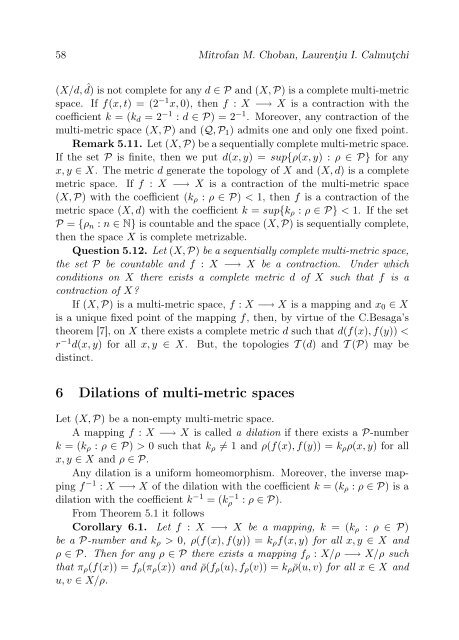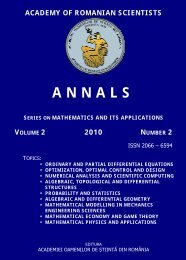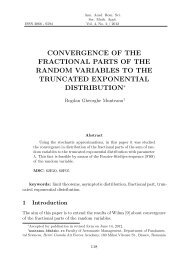3 - Mathematics and its Applications
3 - Mathematics and its Applications
3 - Mathematics and its Applications
Create successful ePaper yourself
Turn your PDF publications into a flip-book with our unique Google optimized e-Paper software.
58 Mitrofan M. Choban, Laurențiu I. Calmuțchi(X/d, ˆd) is not complete for any d ∈ P <strong>and</strong> (X, P) is a complete multi-metricspace. If f(x, t) = (2 −1 x, 0), then f : X −→ X is a contraction with thecoefficient k = (k d = 2 −1 : d ∈ P) = 2 −1 . Moreover, any contraction of themulti-metric space (X, P) <strong>and</strong> (Q, P 1 ) adm<strong>its</strong> one <strong>and</strong> only one fixed point.Remark 5.11. Let (X, P) be a sequentially complete multi-metric space.If the set P is finite, then we put d(x, y) = sup{ρ(x, y) : ρ ∈ P} for anyx, y ∈ X. The metric d generate the topology of X <strong>and</strong> (X, d) is a completemetric space. If f : X −→ X is a contraction of the multi-metric space(X, P) with the coefficient (k ρ : ρ ∈ P) < 1, then f is a contraction of themetric space (X, d) with the coefficient k = sup{k ρ : ρ ∈ P} < 1. If the setP = {ρ n : n ∈ N} is countable <strong>and</strong> the space (X, P) is sequentially complete,then the space X is complete metrizable.Question 5.12. Let (X, P) be a sequentially complete multi-metric space,the set P be countable <strong>and</strong> f : X −→ X be a contraction. Under whichconditions on X there exists a complete metric d of X such that f is acontraction of X?If (X, P) is a multi-metric space, f : X −→ X is a mapping <strong>and</strong> x 0 ∈ Xis a unique fixed point of the mapping f, then, by virtue of the C.Besaga’stheorem [7], on X there exists a complete metric d such that d(f(x), f(y)) 0 such that k ρ ≠ 1 <strong>and</strong> ρ(f(x), f(y)) = k ρ ρ(x, y) for allx, y ∈ X <strong>and</strong> ρ ∈ P.Any dilation is a uniform homeomorphism. Moreover, the inverse mappingf −1 : X −→ X of the dilation with the coefficient k = (k ρ : ρ ∈ P) is adilation with the coefficient k −1 = (kρ−1 : ρ ∈ P).From Theorem 5.1 it followsCorollary 6.1. Let f : X −→ X be a mapping, k = (k ρ : ρ ∈ P)be a P-number <strong>and</strong> k ρ > 0, ρ(f(x), f(y)) = k ρ f(x, y) for all x, y ∈ X <strong>and</strong>ρ ∈ P. Then for any ρ ∈ P there exists a mapping f ρ : X/ρ −→ X/ρ suchthat π ρ (f(x)) = f ρ (π ρ (x)) <strong>and</strong> ¯ρ(f ρ (u), f ρ (v)) = k ρ ¯ρ(u, v) for all x ∈ X <strong>and</strong>u, v ∈ X/ρ.






